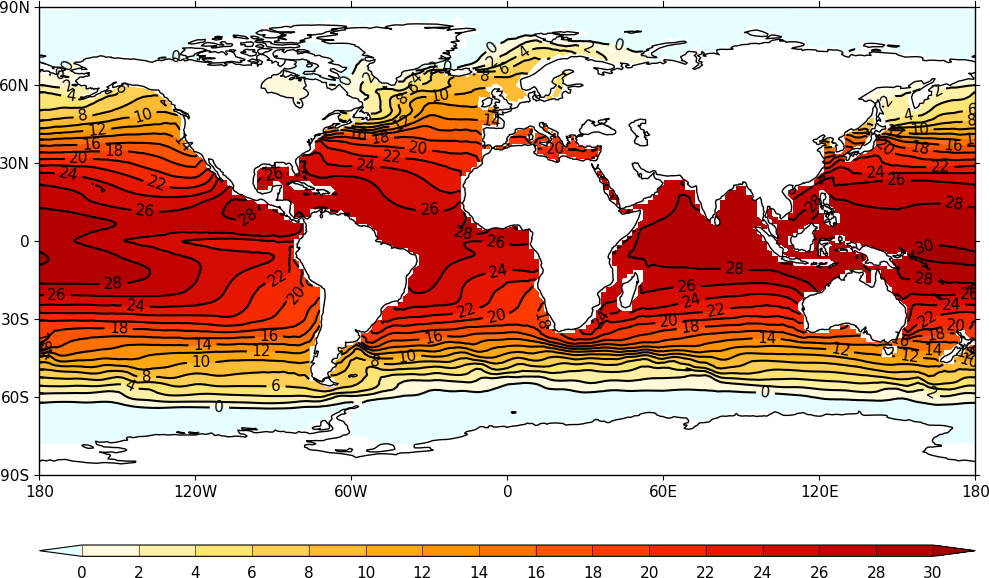The Python cf package is an Earth Science data analysis library that
is built on a complete implementation of the CF data model.
http://ncas-cms.github.io/cf-python
https://ncas-cms.github.io/cf-python/tutorial.html
http://ncas-cms.github.io/cf-python/installation.html
The cf package implements the CF data model
(https://doi.org/10.5194/gmd-10-4619-2017) for its internal data
structures and so is able to process any CF-compliant dataset. It is
not strict about CF-compliance, however, so that partially conformant
datasets may be ingested from existing datasets and written to new
datasets. This is so that datasets which are partially conformant may
nonetheless be modified in memory.
A simple example of reading a field construct from a file and inspecting it:
>>> import cf
>>> f = cf.read('file.nc')
>>> print(f)
Field: air_temperature (ncvar%tas)
----------------------------------
Data : air_temperature(time(12), latitude(64), longitude(128)) K
Cell methods : time(12): mean (interval: 1.0 month)
Dimension coords: time(12) = [0450-11-16 00:00:00, ..., 0451-10-16 12:00:00] noleap
: latitude(64) = [-87.8638, ..., 87.8638] degrees_north
: longitude(128) = [0.0, ..., 357.1875] degrees_east
: height(1) = [2.0] m
The cf package can:
-
read field constructs from netCDF, CDL, PP and UM datasets,
-
create new field constructs in memory,
-
write field constructs to netCDF datasets on disk,
-
read, write, and create coordinates defined by geometry cells (new in version 3.2.0),
-
read netCDF and CDL datasets containing hierarchical groups (new in version 3.6.0),
-
inspect field constructs,
-
test whether two field constructs are the same,
-
modify field construct metadata and data,
-
create subspaces of field constructs,
-
write field constructs to netCDF datasets on disk,
-
incorporate, and create, metadata stored in external files (new in version 3.0.0),
-
read, write, and create data that have been compressed by convention (i.e. ragged or gathered arrays), whilst presenting a view of the data in its uncompressed form,
-
combine field constructs arithmetically,
-
manipulate field construct data by arithmetical and trigonometrical operations,
-
perform statistical collapses on field constructs,
-
perform histogram, percentile and binning operations on field constructs (new in version 3.0.3),
-
regrid field constructs with (multi-)linear, nearest neighbour, first- and second-order conservative and higher order patch recovery methods,
-
apply convolution filters to field constructs,
-
create moving means from field constructs (new in version 3.3.0),
-
calculate derivatives of field constructs,
-
create field constructs to create derived quantities (such as vorticity).
All of the above use LAMA functionality, which allows multiple fields larger than the available memory to exist and be manipulated.
This version of
cfis for Python 3 only and there are incompatible differences between versions 2.x and 3.x ofcf.Scripts written for version 2.x but running under version 3.x should either work as expected, or provide informative error messages on the new API usage. However, it is advised that the outputs of older scripts be checked when running with Python 3 versions of the
cflibrary.For version 2.x documentation, see the older releases page.
Powerful, flexible, and very simple to produce visualizations of field
constructs are available with the cfplot package
(http://ajheaps.github.io/cf-plot), that needs to be installed
seprately to the cf package.
See the cf-plot gallery (http://ajheaps.github.io/cf-plot/gallery.html) for the full range range plotting possibilities with example code.
During installation the cfa command line utility is also
installed, which
-
generates text descriptions of field constructs contained in files, and
-
creates new datasets aggregated from existing files.
Tests are run from within the cf/test directory:
python run_tests.py










